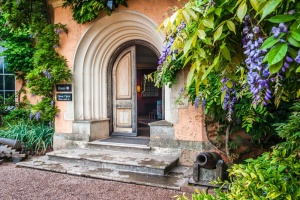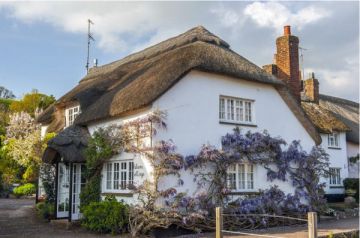HOUSE

The Killerton Estate is first mentioned in 1242. It is believed that the name originated with a family named Kildrington. In the Elizabethan period, the estate was sold to the Acland family, who owned the adjoining property at Columb John. In the late 18th century Sir Thomas Acland, the 7th Baronet, decided to move the family seat to Killerton.
He asked James Wyatt to design a new house, but he did not get along with Wyatt and dismissed him in favour of a relative unknown, named John Johnson, who was instructed by Sir Thomas to build a temporary residence until a more elaborate home could be built on the hill above the site.
As it turned out, Sir Thomas's son died shortly after, in 1778, and he abandoned plans for a second mansion. The 'temporary' house was remodelled and expanded several times over the subsequent centuries, but it is essentially the same building that Johnson planned. And that's part of the charm of Killerton; it has changed so little that if Sir Thomas were here today he would instantly recognise his grand family home.

The interiors a wonderful mix of period styles, from Georgian to Edwardian, with displays of family portraits and a 'hands-on' music room where visitors are encouraged to play the grand piano and pipe organ.
Lady Harriet Acland
In the drawing room is a portrait of a rather pleasant elderly lady dressed in green robes. Nothing remarkable in that, but then you see a small painting on a display easel nearby showing the same woman decades earlier, in a more dramatic pose, crossing a river in winter. The story behind this painting is a fascinating one that sounds like something out of a romantic novel, but for the fact that it is true.
Harriet Acland (1749-1815) was the daughter of the Earl of Ilchester. In 1770 she married Major John Acland. When Acland was sent to America in 1776 to command the 20th Foot Regiment, Lady Harriet accompanied him (according to one source she brought along her mother, a valet, a lady's maid, and a dog). Major Acland was gravely wounded and captured in the second Battle of Saratoga in 1777.

The pregnant Lady Harriet, when hearing the news, travelled through the night, bringing with her a chaplain, her maid, and her husband's personal valet. The small party crossed the Hudson River in darkness, to the enemy camp, to appeal for her husband's release so that she could nurse him back to health. The American commander, General Gates, moved by her courage, agreed to let Lady Harriet join her husband while he was still a captive.
Lady Harriet nursed her husband while he was held by the Americans, and they were later released, and by January 1778 he had recovered enough to return to England. Lady Harriet gave birth to their son John during the voyage home. As for Major Acland, he died later that year after, but not of his wounds; rather, he caught a bad cold while fighting a duel in defence of American honour.
Lady Harriet never remarried, and her bravery made her a celebrity, and her journey to find her husband was commemorated in the dramatic painting by Robert Pollard.
The painting overdoes the drama a bit, though, showing Lady Harriet heroically standing upright in the boat, a rather unlikely scenario. The painting was used to create an extremely popular edition of prints. The meticulous journal that she kept during her time in America was later published, enhancing her reputation as a heroine.
As fascinating as the story is, pride of place in the interior is the Killerton costume collection. The first floor of the house is given over to the collection, which displays a fresh set of 7000 items each year.
The estate is immense, stretching to over 6400 acres, including working farms and 240 cottages. Of these, almost 30 are of medieval origin, including Marker's Cottage. The cottage boasts an excellent medieval painted screen with an unusual mix of secular and religious themes.
Killerton's Gardens
The gardens at Kilerton include an 18-acre hillside garden within 4000 acres of woodland, originally created at the time the house was built by Scotsman John Veitch. Veitch was an interesting character; the story goes that he walked from Edinburgh to London to look for work. He found employment as a nurseryman, and Sir Thomas Acland asked him to create a garden at Killerton, improving on the natural landscape.

Veitch and his son James created a network of woodland paths and planted varieties of foreign trees and shrubs, including Wellingtonia. Because of its mild climate Killerton was used as something of a trial ground for plants brought back from all corners of the globe, and many plants which are now found throughout the British Isles were first planted at Killerton.
Later the influential Victorian garden writer William Robinson had a hand in the design of the Killerton gardens. Killerton is famous for trees and shrubs. There are a series of terraced beds, with dwarf shrubs and copious rhododendrons. Circular walks through the woods provide for an enjoyable outing.
Above the house is a "clump" or hillfort dating to the Iron Age. The hill, also known as Dolbury, is reputed in folklore to be protected by the Killerton Dragon, which every night flies between Killerton and Cadbury Hill to keep safe a hidden treasure.
The Chapel
A short distance from the house is Killerton Chapel, erected as a private family chapel for Sir Thomas Acland and his wife Lydia in 1841 and now used for regular concerts in the summer months. The interiors are pure Victoriana, with rich materials and beautiful stained glass. The design is said to have been inspired by the Norman Lady Chapel at Glastonbury Abbey in Somerset.
The estate at Killerton, as well as that at Holnicote, was given to the National Trust by Sir Richard Acland, whose left-leaning political beliefs precluded his ownership of such a vast tract of land. There are three more National Trust properties on the Killerton Estate - Marker's Cottage, a 15th-century cob and thatch dwelling, Clyston Mill, an 18th century restored water mill, and Budlake Old Post Office Room, the old village shop and post office for the area.
INSIDE THE HOUSE





GARDENS AND GROUNDS




About Killerton
Address: Broadclyst,
Exeter,
Devon,
England, EX5 3LE
Attraction Type: Historic House
Location: 7 m NE Exeter, on B3181
Website: Killerton
Email: killerton@nationaltrust.org.uk
National Trust - see also:
National Trust memberships (official website link)
Location
map
OS: SS977 001
Photo Credit: David Ross and Britain Express
HERITAGE
 We've 'tagged' this attraction information to help you find related historic attractions and learn more about major time periods mentioned.
We've 'tagged' this attraction information to help you find related historic attractions and learn more about major time periods mentioned.
Find other attractions tagged with:
18th century (Time Period) -
NEARBY HISTORIC ATTRACTIONS
Heritage Rated from 1- 5 (low to exceptional) on historic interest
Killerton Chapel - 0.2 miles (Historic Church) ![]()
Budlake Old Post Office Room - 0.3 miles (Historic Building) ![]()
Broadclyst, St John's Church - 1.8 miles (Historic Church) ![]()
Marker's Cottage - 1.9 miles (Historic Building) ![]()
Clyston Mill - 1.9 miles (Historic Building) ![]()
Upton Pyne, Church of Our Lady - 4.4 miles (Historic Church) ![]()
Fursdon - 4.4 miles (Historic House) ![]()
Plymtree, St John the Baptist Church - 5 miles (Historic Church) ![]()
Nearest Holiday Cottages to Killerton :
Stoke Canon, Devon
Sleeps: 16
Stay from: £2732 - 10770
More self catering near Killerton




